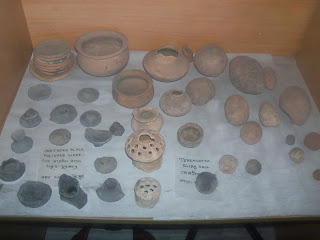The greatest treasure revealed by the excavations at Wari Bateshwar, of course, is evidence that the Ganges Basin civilisation, one of the earliest known industrialised civilisations in the world, reached along almost the entire length of the great Ganges, once it entered the lowlands from the Himalayas.
Despite being located on the banks of the Old Brahmaputra, some 40km or so north of the ancient junction between the two greatest of South Asian rivers, the evidence of metal working and manufacturing and the cutting of gemstones and making of jewellery, that characterised the manufacturing works of the Civilisation, gives clear evidence that this was, indeed, the easternmost area of settlement.
Another 40 km further upstream of the ancient course of the Brahmaputra, the material excavated at Egarasindhur, near Kishoreganj, in the one season of ‘digging’ in 1935, may well mark out the northern fringe of settlement.
The bronze horse excavated at Wari Bateshwar is not without its significance, since the Harappan people, who are thought to have been early settlers in the area, had no horses, whereas the Aryan nomads did have them.
The early coinage including the 6th Century dated silver coins that, if not in fact the earliest coinage in the world…and they may prove to be...are at least roughly contemporary with the coinage of Mesopotamia that has, hitherto, been thought the world’s earliest.
Whilst many of the many beads in items of jewellery are undoubtedly locally made, the presence of glass beads of a uniquely Roman origin manifest the reality of the historian Strabo’s 17AD ‘Geographia’ claimm of merchants sailing ‘even to the Ganges’.
Amongst a great deal of pottery, there are ‘ring and knob’ bowls, identified by Cambridge University specialists as being of Buddhist significance, and a dish inscribed with animist, shamanic and Buddhist iconography, suggesting the origins of Japan’s unique Shinto belief group.
Year by year the slow, and very underfunded, work of excavation is slowly revealing more of the treasures that bear testimony to the industrialised civilisation that clearly commenced international trade at an early period, maybe even as early as 1,500 BCE.
It may take years to reveal all that Wari Bateshwar can tell us about civilisation in the Ganges delta, and even then, there is more potential in, at least, Egarasindhur, and probably Vikrampur amongst the ancient communities that are scattered across Bangladesh, beside the great rivers that were the trading routes and communication lines of the ancient world.





Good article, as a research assistant and student of archaeology department of Jahangirnagar university I have worked there more than Five years.
ReplyDelete